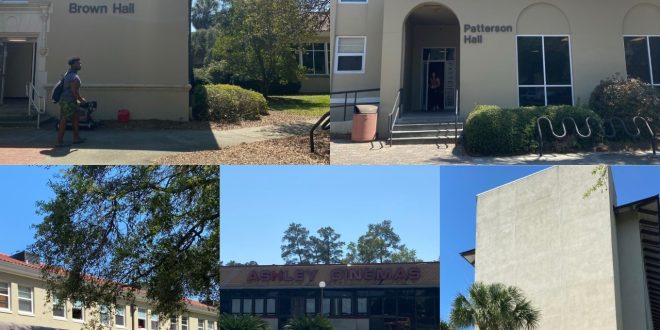Ashley Cinemas
Ashley Cinema, established in 1979, was named after the Ashley Street, also named after William Ashley, who was a physician and slaveholder.
This was not the first to request this name change. Citizens of Valdosta have proposed changing the name because of Ashley’s position as an enslaver of at least 17 African Americans during his lifetime.
There is no record of the kind of labor required of the people Ashley enslaved, but the 1860 census includes them in his household in Texas. They were between the ages two and 50.
There is no record if he enslaved people earlier in his life. Ashley died in 1867.
Ashley’s son, Cornelius Raines Ashley, was born in 1858. He helped create the South Georgia State Normal College for Young Ladies which is now known as Valdosta State University. He also served as treasurer on the school’s board of trustees.
VSU has moved forward with changing Ashley Cinemas to a new performing arts center. There are hopes for it to be open as early as fall 2023, according to the VSU website.
Brown Hall
VSU’s Brown Hall, a co-ed freshman dorm housing around 200 students, is named after Joseph Mackey Brown.
VSU decided to name the hall in honor of Joseph Brown in 1913 because he was the governor of Georgia at that time. His father was the governor of Georgia during the Civil War.
Brown was also one of the ring leaders who orchestrated the 1915 lynching of Leo Frank.
Frank was a factory superintendent in Atlanta, Georgia. He was convicted in 1913 of the rape and murder of a 13-year-old employee Mary Phagan.
The trial, conviction and appeal attracted national attention. The announcement of his death sentence became the focus for concerns regarding antisemitism [hostility to or prejudice against Jewish people].
Brown rhetorically asked in the Dec. 27, 1914 issue of the Augusta Chronicle whether Georgians should accept that “anybody except a Jew can be punished for a crime.”
Less than a year later, Brown wrote another article published in the Macon Telegraph where he encouraged “the people to form mobs,” in order to ensure justice was carried out for the case.
On Aug. 16, 1915, Frank was kidnapped from prison by a group of armed men. He was taken to Phagan’s hometown, Marietta, Georgia. and lynched the next morning.
The governor at that time vowed to punish the lynchers; however, no one was charged. Frank was pardoned by the Georgia State Board of Pardons and Parole.
It was later discovered that Jim Conley killed Phagan.
Langdale Hall
Langdale Hall, a traditional co-ed dorm housing nearly 500 students, is named after John Wesley Langdale, a pioneer and founder of Langdale Forest Products Company, one of Georgia’s largest turpentine enterprises.
While Langdale and his descendants have had a lasting impact on the various industries in Lowndes County and across South Georgia, Langdale also practiced debt peonage, or what some refer to as debt slavery.
This post-slavery tactic was popular among landowners as it allowed them to profit off cheap labor, primarily that of African Americans. Langdale Forest Products was no different, as most of their workers were of African American descent.
His system of debt ensured that those who worked for him could not legally leave the turpentine camps. Workers also had other freedoms restricted and were not allowed to ask for pay raises.
Additionally, African American workers were subjected to cruel conditions on his land by suffering from abuse from Langdale’s overseers. The loosely regulated safety standards resulted in workers suffering from the effects of toxic fumes and physical injuries sustained while on the job.
Prior to his death in 1911, he and his wife and daughters relocated to Jasper, Florida, with Langdale himself believing that the conditions of his camps were not ideal for his family.
The Langdales remain one of the most well-known families in South Georgia.
Lowndes Hall
VSU’s Lowndes Hall, a residence hall for freshmen, was revealed to have been named after William Jones Lowndes, a former South Carolina politician and slave owner.
William Jones Lowndes is also whom the county of Lowndes is named after.
Lowndes was born on Feb. 11, 1782 in St. Bartholomew’s Parish, South Carolina at the Horseshoe Plantation. His father was also a politician and slave owner in South Carolina.
Throughout his life, Lowndes has enslaved numerous African Americans who he obtained through his parents and his marriage to Elizabeth Breton Pinckney. Pinckney was the daughter of a South Carolina politician.
Lowndes also bought and sold salves throughout his life. His slaves included both men and women.
The population of Lowndes’ enslaved people varied throughout his life. According to the report, at the end of his life, his will listed 119 slaves as his property.
Located near Odum Library and the fine arts building, Lowndes Hall is a freshmen-focused dorm that is home to 196 students on-campus.
Aside from politics and slavery, Lowndes played a significant role in the creation of the Second Bank of the United States. He also worked with Henry Clay to pass the Missouri Compromise in 1820. Lowndes died in October 1822.
Patterson Hall
James W. Patterson was a lawyer and teacher for Troupville and Valdosta in the mid-1800s. He was able to get a street named after him and one of VSU buildings: Patterson Hall.
Patterson was an owner of at least 14 slaves ranging in ages one to 50, and he died in the Battle of McDowell on May 8,1862, fighting to preserve the enslavement of African Americans in the South.
The hall is a co-ed residential dorm building for freshmen and can house up to 284 students.
Patterson also organized a company of infantry in Lowndes County after the outbreak of the Civil War, which he was named captain of.
Due to the history of the building’s namesake, some students think that Patterson Hall should be renamed.
“Even though he fought for the Civil War and was an asset to the community doesn’t mean we should commemorate him,” Akil Lampley, a freshman accounting major and Black resident of Patterson Hall, said.
However, not every student is bothered by it, like Eriana Jones, a junior theater major and Black RA for Patterson Hall. She doesn’t think the change is necessary.
“But, I think it would be a big deal in Valdosta if it did,” she said. “It would show that the school cares about the history and its students.”
Every student admitted that they didn’t know the history of the building they were living in, and that it should be talked about more.
“The school should speak about the history, recognizing it was wrong,” Jones said.
Ashley Cinemas written by Jonnie Brewer, Managing Editor. Brown Hall written by Sam Acevedo, Campus Life Editor. Langdale Hall written by Austin Bruce, Sports Editor. Lowndes Hall written by TJ Weaver, Editor In Chief. Patterson Hall written by Angel Davis, Staff Writer. Photo courtesy of Jonnie Brewer, Managing Editor.
 The Spectator The independent student newspaper of Valdosta State University
The Spectator The independent student newspaper of Valdosta State University







